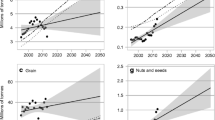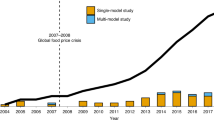Abstract
The United Nations Food and Agriculture Organization (FAO) estimate that nearly 900 million people on the planet are suffering from chronic hunger. This state of affairs led to the making of the United Nations Millennium Development Goals in 2000, having the first goal to “Eradicate extreme poverty and hunger” with a target to halve the proportion of people who suffer from hunger. However, projections of a rapidly growing population, coupled with global climate change, is expected to have significant negative impacts on food security. To investigate this prospect, a modelling framework was developed under the QUEST-GSI programme, which we have termed FEEDME (Food Estimation and Export for Diet and Malnutrition Evaluation). The model uses country-level Food Balance Sheets (FBS) to determine mean calories on a per-capita basis, and a coefficient of variation to account for the degree of inequality in access to food across national populations. Calorific values of individual food items in the FBS of countries were modified by revision of crop yields and population changes under the SRES A1B climate change and social-economic scenarios respectively for 2050, 2085 and 2100. Under a no-climate change scenario, based upon projected changes in population and agricultural land use only, results show that 31 % (2.5 billion people by 2050) of the global population is at risk of undernourishment if no adaptation or agricultural innovation is made in the intervening years. An additional 21 % (1.7 billion people) is at risk of undernourishment by 2050 when climate change is taken into account. However, the model does not account for future trends in technology, improved crop varieties or agricultural trade interventions, although it is clear that all of these adaptation strategies will need to be embraced on a global scale if society is to ensure adequate food supplies for a projected global population of greater than 9 billion people.




Similar content being viewed by others
References
Arnell NW (2008) The global-scale impacts of climate change: QUEST-GSI, website: http://www.met.reading.ac.uk/research/quest-gsi/ (last accessed on 12/03/14)
Beddington J (2009) Food, energy, water and the climate: A perfect storm of global events? Government Office for Science, London. Available at www.bis.gov.uk/assets/goscience/docs/p/perfect-storm-paper.pdf (last accessed on 12/03/14)
Challinor AJ, Wheeler TR, Craufurd PQ, Slingo JM, Grimes DIF (2004) Design and optimissation of a large-area process-based model for annual crops. Agric For Meteorol 124:99–120
DEFRA (2013) Agriculture in the UK 2013, 113 pp. Available at www.gov.uk/government/statistics/agriculture-in-the-united-kingdom-2013 (last accessed on 12/08/14)
Delgado CL (2003) Rising consumption of meat and milk in developing countries has created a new food revolution. J Nutr 133(11):3907S–3910S
Ewert F, Rounsevell MDA, Reginster I, Metzger MJ, Leemans R (2005) Future scenarios of European agricultural land use I: estimating changes in crop productivity. Agric Ecosyst Environ 107:101–116
FAO (2004) FAO methodology for estimating undernourishment. Food and Agriculture Organisation, Rome
FAO (2009) How to feed the world in 2050. Food and Agriculture Organisation, Rome, p 35
FAO (2012) The State of Food Insecurity in the World 2012, Food and Agriculture Organisation, Rome. Available at http://www.fao.org/publications/sofi/en/ (last accessed on 12/03/14)
FAO/WHO/UNU (2004) Human Energy Requirements. Report of a Joint FAO/WHO/UNU Expert Consultation. Rome, FAO, FAO Food and Nutrition Tech. Report. Series. 1., Food and Agriculture Organisation, Rome
Geerts S, Raes D, Garcia M, Taboada C, Miranda R, Cusicanqui J, Mhizha T, Vacher J (2009) Modelling the potential for closing quinoa yield gaps under varying water availability in the Bolivian Altiplano. Agri Water Manag 96:1652–1658
Godfray HCJ et al (2010) Food security: the challenge of feeding 9 billion people. Science 327:812–818
James WPT, Schofield EC (1990) Human energy requirements. Oxford University Press, Oxford
Kanerva M (2013) Meat consumption in Europe: Issues, trends and debates, Artec-paper Nr. 187, January 2013, Universitat Bremen, Bremen, ISSN1613-4907, www.academia.edu/2486553/ (Last accessed on 12/03/14)
Kaufmann S (2000) A Selection of indicators for food and nutrition security programmes. Food and Agriculture Organisation, Rome
Leemans R, and van den Born GJ (1994) Determining the potential distribution of vegetation, crops and agricultural productivity (p 133–162) in Alcamo, J (ed.) IMAGE 2.0 Integrated modelling of Global Climate Change
Lobell DB, Cassman KG, Field CB (2009) Crop yield gaps: their importance, magnitudes, and causes. Annu Rev Environ Resour 2009(34):179–204
Lobell DB, Schlenker W, Costa-Roberts J (2011) Climate trends and global crop production since 1980. Science 333:616–620
Maxwell D (1996) Measuring food insecurity: the frequency and severity of ‘coping strategies.’. Food Policy 21:291–303
Mills G, Hayes F, Simpson D, Emberson L, Norris D, Harmens H, Buker P (2011) Evidence of widespread effects of ozone on crops and (semi-)natural vegetation in Europe (1990–2006) in relation to AOT40- and flux-based risk maps. Glob Chang Biol 17:592–613
Nakicenovic N, and Swart R (eds), 2000, Special Report on Emissions Scenarios: A special report of working group III of the Intergovernmental Panel on Climate Change. IPCC
Naylor RL, Battisti DS, Vimont DJ, Falcon WP, Burke MB (2007) Assessing risks of climate variability and climate change for Indonesian rice agriculture. Proc Natl Acad Sci 104:7752–7757
Osborne T, Rose G, Wheeler T (2013) Variation in the global-scale impacts of climate change on crop productivity due to climate model uncertainty and adaptation. Agric For Meteorol 170:183–194
Parry M, Rosenzweig C, Livermore M (2005) Climate change, global food supply and risk of hunger. Philos Trans R Soc B 360:2125–2138
Portmann FT, Siebert S, Döll P (2010) MIRCA2000—Global monthly irrigated and rainfed crop areas around the year 2000: A new high-resolution data set for agricultural and hydrological modeling, Global Biogeochemical Cycles, 24, GB1011, doi:10.1029/2008GB003435
Rosegrant MW, Leach N, Gerpacio RV (1999) Alternative futures for world cereal and meat consumption. Proc Nutr Soc 58:219–234. doi:10.1017/S0029665199000312
Rounsevell MDA, Reginster I, Araujo MB, Carter TR, Dendoncker N, Ewert F, House JI, Kankaanpää S, Leemans R, Metzger MJ, Schmit C, Smith P, Tuck G (2006) A coherent set of future land use change scenarios for Europe. Agric Ecosyst Environ 114:57–68
Simon J (1981) World population growth: an anti-doomsday view. In: Menard SW, Moen EW (eds) Perspectives on population: an introduction to concepts and issues. Oxford University Press, Oxford, pp 123–128
Snowdon DA, Phillips RL, Fraser GE (1984) Meat consumption and fatal ischemic heart disease. Prev Med 13(5):490–500
Tao F, Hayashi Y, Zhang Z, Sakamoto T, Yokozawa M (2008) Global warming, rice production, and water use in China: developing a probabilistic assessment. Agric For Meteorol 148:94–110
Tilman D, Balzerb C, Hill J, Beforta BL (2011) Global food demand and the sustainable intensification of agriculture. PNAS 108(50):20260–20264. doi:10.1073/pnas.1116437108
UN (1975) Report of the World Food Conference, 5–16 November 1974. United Nations, Rome. Available at http://assembly.coe.int/ASP/XRef/X2H-DW-XSL.asp?fileid=15996&lang=en (last accessed on 12/03/14)
UN (2000) United Nations General Assembly, United Nations Millennium Declaration, Resolution Adopted by the General Assembly, 18 September 2000, A/RES/55/2. Available at http://www.un.org/millennium/declaration/ares552e.pdf (last accessed on 12/03/14)
van Vuuren DP, den Elzen MGJ, Lucas PL, Eickhout B, Strengers BJ, van Ruijven B, Wonink S, van Houdt R (2007) Stabilizing greenhouse gas concentrations at low levels: an assessment of reduction strategies and costs. Clim Chang 81:119–159
Acknowledgments
This research was funded under the NERC QUEST-GSI project no. NE/E001866/1.
Author information
Authors and Affiliations
Corresponding author
Additional information
This article is part of a Special Issue on “The QUEST-GSI Project” edited by Nigel Arnell.
Rights and permissions
About this article
Cite this article
Dawson, T.P., Perryman, A.H. & Osborne, T.M. Modelling impacts of climate change on global food security. Climatic Change 134, 429–440 (2016). https://doi.org/10.1007/s10584-014-1277-y
Received:
Accepted:
Published:
Issue Date:
DOI: https://doi.org/10.1007/s10584-014-1277-y




